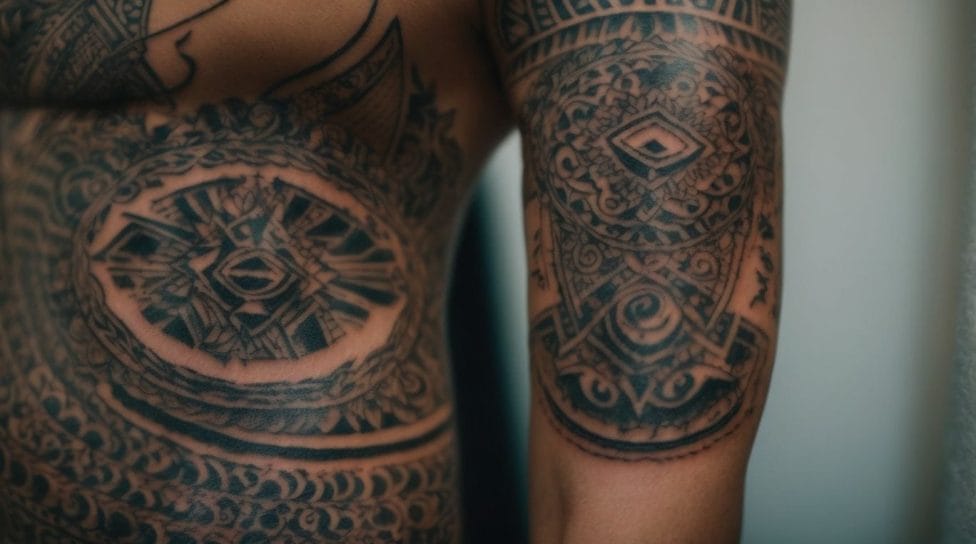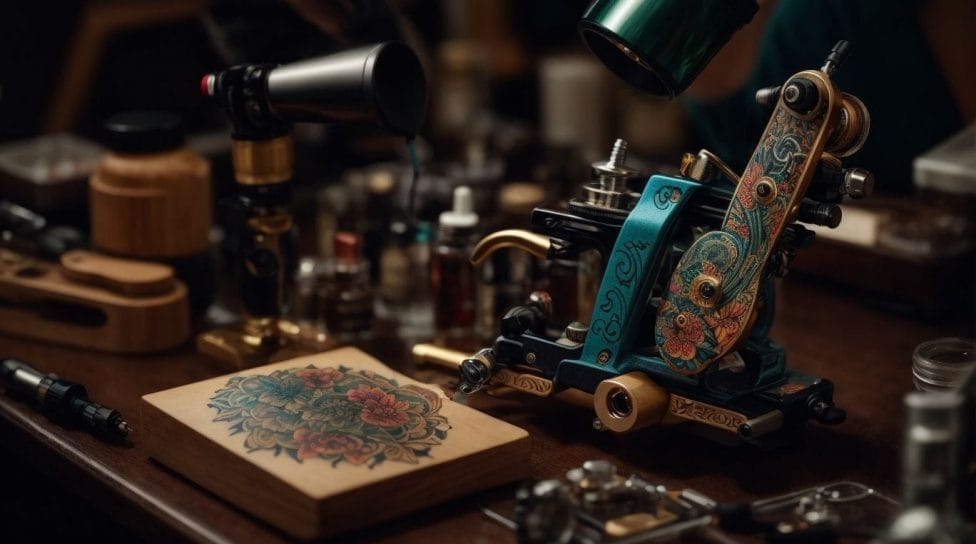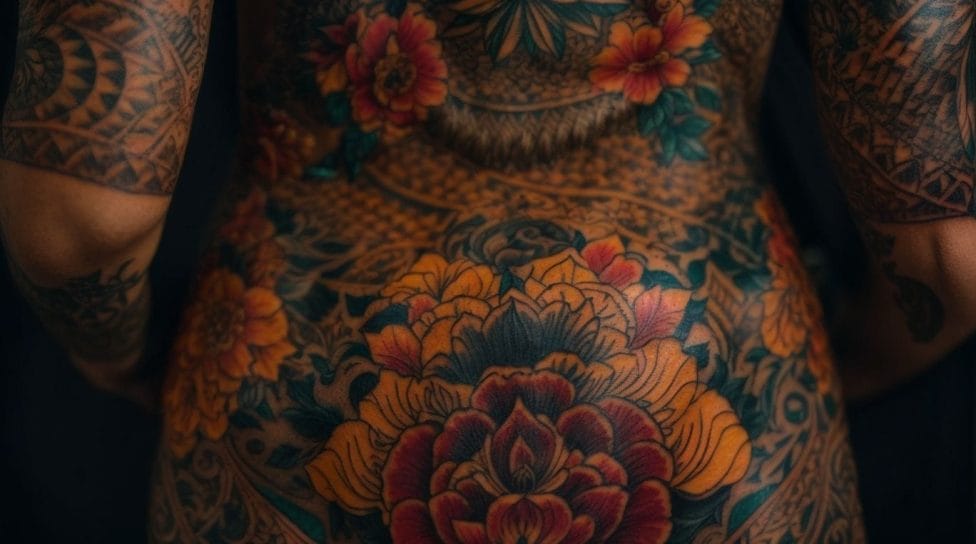Tattooing has a rich and diverse history that spans centuries and cultures. From ancient traditions to modern techniques, tattoos have evolved and become an integral part of contemporary society. This article explores the fascinating origins of tattoos and delves into the question of who invented tattoos.
The history of tattoos can be traced back to early origins when they held significant cultural and social significance. Various ancient cultures, such as the Egyptians, Greeks, and Indigenous tribes, incorporated tattoos into their rituals, rites of passage, and symbols of identity. Throughout the Middle Ages and Renaissance period, tattoos went through a period of decline, only to resurge during the Age of Exploration and the encounters between different cultures.
Pinpointing the exact origin of tattoos is a complex task, as different cultures and civilizations have made notable contributions to the art form. The earliest recorded evidence of tattoos comes from ancient Egypt, where mummies with inked designs dating back thousands of years have been discovered. Polynesians, Japanese, and Native Americans have also played significant roles in the development and spread of tattooing traditions.
The techniques of tattooing have also evolved—traditional methods involved using natural dyes and tools like bone or wooden sticks to create intricate designs. In modern times, advancements in technology and the introduction of electric tattoo machines have revolutionized the art form, allowing for more precision and efficiency in the process.
Tattoos have gained immense popularity and mainstream acceptance in contemporary society. They have become a form of self-expression, commemorating significant events or people, and a way to showcase personal beliefs and cultural heritage. Tattoos hold different meanings for different individuals, and their significance can vary from purely aesthetic to deeply symbolic.
Tattoo artists and influential figures in the industry have played a pivotal role in shaping the art form and pushing boundaries. From renowned tattoo artists like Sailor Jerry and Kat Von D to celebrities who have helped popularize tattoos, their contributions have made tattoos a respected and celebrated art form in their own right.
Key takeaway:
- Tattoos have a long history: Tattoos have been around for centuries, with evidence of their existence dating back to ancient times.
- Origin of tattoos remains unclear: The exact origins of tattoos are shrouded in mystery, with various cultures laying claim to their invention.
- Cultural contributions to tattooing: Different cultures, including the Egyptians, Polynesians, and Native Americans, have significantly contributed to the development and spread of tattooing.
History of Tattoos

Photo Credits: Tattooineplanet.Com by Mason Davis
Want to know the captivating journey of tattoos throughout history? Delve into the intriguing section on the history of tattoos, where we’ll uncover the early origins that date back centuries, explore the significance of tattoos in ancient cultures, dive into the transformative period of the Middle Ages and Renaissance, and finally, bring you into the realm of modern times. Prepare to be amazed as we unravel the captivating stories and evolution behind the art of tattoos.
Early Origins of Tattoos
The early origins of tattoos can be traced back to ancient cultures worldwide. In the Upper Paleolithic period, around 10,000 BCE, evidence of tattooing was found on clay figurines and mummified preserved skin. Ancient Egyptians used tattoos for religious and cultural purposes, while ancient Greeks used them to signify status. Indigenous Polynesians developed intricate tattooing techniques and patterns. In the Americas, Native South Americans and pre-Columbian societies utilized tattoos for various reasons. These early tattoo practices laid the foundation for the art form as we know it today. Exploring these early origins of tattoos helps us appreciate the rich history and cultural significance of this ancient form of body art. Who Invented Tattoos?
For further reading, refer to the book “Skin: A Natural History” by Professor Nina Jablonski. It offers a comprehensive exploration of tattooing across different times and cultures.
Tattoos in Ancient Cultures
Tattoos in Ancient Cultures hold a significant position in history, displaying a diverse range of meanings and importance. These tattoos were utilized for various purposes, such as signifying social status, expressing deep-rooted religious beliefs, or even acting as a form of protective symbol. To exemplify, the ancient Egyptians embraced tattoos to pay tribute to their deities, while the indigenous Polynesians employed them to represent their lineage and cultural heritage. It is intriguing to note that tattoos have been discovered on mummified bodies, dating back thousands of years, serving as concrete proof of their existence in ancient eras. In these ancient cultures, distinct tattooing techniques and materials were employed, which included bone, shells, and naturally derived pigments. Through studying tattoos in ancient cultures, we gain a fascinating window into the diverse traditions and beliefs held by our ancestors.
Middle Ages and Renaissance
During the Middle Ages and Renaissance, tattoos underwent a significant shift in perception and usage. In the Middle Ages, tattoos were associated with criminals and outcasts, often serving as punishment. In the Renaissance, tattoos became more popular among the upper class, indicating social status and wealth. Religious themes, including symbols of faith and protection, influenced the designs during this time. Tattooing techniques also evolved, introducing more advanced tools and pigments. The Middle Ages and Renaissance marked a pivotal point in the history of tattoos, shaping their significance and cultural connotations.
Tattoos in Modern Times
In modern times, tattoos have become increasingly popular and widely accepted, making them a prominent feature of contemporary culture. They are now seen as a highly valued form of self-expression and body art. Thanks to advancements in technology and techniques, tattoo artists can now create more intricate and elaborate designs, showcasing their immense skill and creativity. With a wider range of vibrant colors and innovative tools, these artists transform their clients’ ideas into breathtaking visual representations of their skin. It’s fascinating to observe how tattoos have transitioned from a niche interest to a mainstream phenomenon, with celebrities and athletes proudly displaying their inked bodies. This cultural shift has fostered a deeper appreciation and understanding of tattoos as a legitimate and profound art form in our society.
In the context of tattoos in modern times, one particular individual’s story stands out – that of Kat Von D. Renowned both as a talented tattoo artist and a reality T.V. star, she has played a significant role in the increasing acceptance and admiration of tattoos as a legitimate art form. Kat Von D’s creative contributions have been instrumental in breaking down societal barriers and encouraging others to embrace tattoos as a powerful medium of self-expression. Moreover, she has utilized her influential platform to advocate for animal rights and ethical beauty brands, convincing the world that tattoos can carry a positive impact on society beyond aesthetics. Kat Von D’s journey truly epitomizes the transformative potential of tattoos in modern times.
Who Invented Tattoos?

Photo Credits: Tattooineplanet.Com by Roger Clark
Discovering the origins of tattoos is a fascinating journey. In this dive into the history of body art, we’ll explore the rich tapestry of human expression and symbolism. From exploring the earliest recorded evidence of tattoos to uncovering the contributions made by different cultures, we’ll unveil the captivating world behind this ancient practice. So, grab your imaginary time machine, and let’s embark on a quest to unravel who invented tattoos.
Exploring the Origins
Exploring the Origins of tattoos allows us to embark on a captivating journey into the depths of ancient civilizations and their cultural practices. The art of body modification holds a fascinating history that even predates written records. Delving back to the Upper Paleolithic period, it becomes apparent that tattoos were not merely ornamental but played meaningful roles in religious devotion and warding off evil forces. As we unravel the tales of tattooed Egyptian mummies in ancient Egypt, it becomes evident that tattooing was prevalent all across the globe. Not only did Indigenous Polynesians, Gypsy tribes, and ancient Chinese cultures embrace various forms of tattoo art, but tattoos have also served as powerful tools for self-expression, cultural identity, and, at times, even methods of punishment throughout the tapestry of human history.
Earliest Recorded Evidence
The Upper Paleolithic era, around 3300 B.C.., provides the earliest recorded evidence of tattoos. This evidence comes from various archaeological sites, including the preserved and tattooed skin of mummified ancient Egyptian bodies. These tattoos held different meanings and served various purposes in ancient cultures. They were used to represent status, provide protection against evil, express love, and even as a form of punishment. During this time, tattooing techniques relied on tools such as fish bones, citrus thorns, and obsidian skin piercers. The early origins of tattoos highlight the rich and ancient art of body decoration.
Contributions from Different Cultures
The contributions from different cultures have played a significant role in the development and evolution of tattooing throughout history. These diverse cultural influences have shaped and enriched the art of tattooing, leaving a lasting impact on its practice and symbolism that continues to this day.
Here is a table showcasing some of the notable cultural contributions to tattoo art:
| Culture | Contribution |
|---|---|
| Ancient Egyptians | The earliest evidence of tattooing is used for religious and magical purposes. |
| Indigenous Polynesians | Developed intricate and meaningful Polynesian tattoo designs. |
| Ancient Greeks | Tattoos were seen as a status symbol and a form of punishment. |
| Native South Americans | Utilized tattoos for body decoration and to signify social status. |
| Austronesian People | Practiced traditional hand-tapping techniques for tattooing. |
These various contributions from different cultures highlight the significance of cultural diversity in tattoo art. Ta’s multitude of traditions and practices across different regions has influenced tattooing periods. It is through the amalgamation of these contributions that the art of tattooing has evolved into what it is today.
The Evolution of Tattooing Techniques

Photo Credits: Tattooineplanet.Com by Randy Robinson
Tattooing has come a long way, evolving from traditional techniques to modern methods. In this fascinating journey through the history of tattooing, we will explore the techniques used to create these lasting works of art. From the ancient origins to the cutting-edge innovations of today, join us as we delve into the world of tattooing and uncover the captivating tales behind traditional and modern tattooing methods.
Traditional Techniques
Traditional tattooing techniques have a rich history across different cultures and periods. These traditional techniques involve using tools and methods passed down through generations. Some examples of traditional tattooing techniques include hand-tapping, where a needle is manually tapped into the skin with a wooden or metal tool, and stick-and-poke, which involves using a single needle and ink to create the tattoo. These traditional techniques require skill and precision, and they are still practiced today by tattoo artists who appreciate the craftsmanship and authenticity they bring to the art form.
In the remote villages of Thailand, these traditional tattooing techniques are still practiced by skilled artisans. One such artisan, named Piya, learned the art of hand-tapping tattoos from his grandfather. He uses a bamboo rod with a needle to hand-tap intricate designs onto the skin. Through his tattoos, Piya preserves cultural traditions and helps pass on the stories and beliefs of his community to the younger generation. His dedication to these traditional techniques keeps the art form alive and reminds us of the importance of honoring our heritage.
Modern Tattooing Methods
- Modern tattooing methods have evolved significantly, providing more precise and intricate designs. Here are some techniques used in contemporary tattooing:
- Electrical Tattoo Machines: These machines use electromagnetic coils to move the tattoo needles up and down rapidly, creating the desired design.
- Rotary Tattoo Machines: These machines use a rotating mechanism instead of coils, offering quieter and smoother operation.
- Laser Tattoo Removal: This method uses modern tattooing methods and laser technology to break down the tattoo ink particles, allowing them to be naturally eliminated by the body’s immune system.
- Microblading: This technique, primarily used for eyebrow tattoos, involves manually depositing pigments into the skin using a handheld tool with microneedles.
- Watercolor Tattoos: This style mimics the look of watercolor paintings, using softer lines and more vibrant colors.
Fun fact: Did you know that the earliest evidence of tattooing dates back to around 5,000 BCE and was found on the mummified preserved skin of Ötzi the Iceman?
Tattoos in Contemporary Society

Photo Credits: Tattooineplanet.Com by Daniel Lewis
Tattoos in contemporary society have brought about a cultural shift, embracing popularity and mainstream acceptance. Join us as we delve into the world of tattoos and explore the significance and meanings they hold in this modern era. Discover the captivating allure behind these artistic expressions and uncover the stories beneath the inked skin.
Popularity and Mainstream Acceptance
Tattoos have become increasingly popular and widely accepted in contemporary society. They have gained mainstream acceptance due to several key factors:
- Self-expression: Tattoos are regarded as a personal expression, enabling individuals to showcase their unique identities and beliefs.
- Cultural significance: Tattoos are significant for numerous communities, serving as heritage symbols and a sense of belonging.
- Celebrity influence: The prevalence of tattoos among famous figures, such as musicians and actors, has contributed to the normalization and popularization of tattoo culture.
- Advancements in tattoo technology: Modern advancements in tattooing techniques have made it easier to create intricate designs and vibrant colors.
- Increased social acceptance: With the growing prevalence of tattoos, society’s attitudes towards them have shifted, resulting in greater acceptance even in professional settings.
Tattoos have come a long way throughout history, with their popularity and mainstream acceptance evolving.
Significance and Meanings of Tattoos
Tattoos have significant meanings and symbolism across different cultures and periods. They can represent personal beliefs, cultural heritage, achievements, or even acts of rebellion. In ancient Egypt, tattoos were believed to protect wearers and signify status. In Polynesian culture, tattoos were seen as a form of storytelling to communicate important life events. In contemporary society, tattoos have become more mainstream and can hold personal significance for individuals, expressing their individuality or marking a significant life event. Understanding the significance and meanings of tattoos can help us appreciate their cultural and personal importance throughout history.
The significance and meanings of tattoos transcend cultural boundaries and span through various eras. Tattoos carry immense symbolic weight, signifying personal beliefs, cultural heritage, accomplishments, and sometimes rebelliousness. In ancient Egypt, tattoos were revered as a means of safeguarding individuals and signifying their esteemed social status. Polynesian culture, on the other hand, viewed tattoos as a powerful medium for storytelling, conveying pivotal moments in life. As times have evolved, tattoos have permeated mainstream society, holding profound personal importance for people as they express their unique identities or commemorate significant milestones. A profound comprehension of the significance and meanings of tattoos enables us to truly grasp their cultural and personal significance that has persisted throughout history.
Tattoo Artists and Influential Figures

Photo Credits: Tattooineplanet.Com by Justin Clark
When exploring the history of tattoos, it’s fascinating to discover the influential figures and talented tattoo artists who have shaped the art form.
- Norman Keith Collins, known as Sailor Jerry, revolutionized tattooing by incorporating bold, traditional American designs.
- Recognized for his Japanese-inspired designs, Don Ed Hardy played a significant role in popularizing tattoo art in the Western world.
- A prominent contemporary tattoo artist, Kat Von D gained fame through her appearances on reality shows and unique style.
- Tattooing in Indigenous Cultures: Tattoo artists from indigenous cultures, such as Maori moko tattooists and Samoan tufuga ta tatau, have preserved and passed down traditional tattooing techniques.
Pro-tip: Learning about the contributions of these tattoo artists and influential figures can enhance your appreciation for the rich history and artistry behind tattoos.
Some Facts About Who Invented Tattoos:
- ✅ tattooing is an ancient practice that has been important to people for over 10,000 years. (Source: Our Team)
- ✅ The oldest documented tattoos belong to Otzi the Iceman, who lived around 3300 B.C. (Source: Our Team)
- ✅ tattooing has been found in various ancient civilizations, including Japan, Egypt, Siberia, Crete, Greece, Arabia, China, Celtic and Northern European tribes, and Samoa and the Polynesian islands. (Source: Our Team)
- ✅ tattooing became prohibited in Europe due to its association with paganism and the criminal class in the rise of Christianity. (Source: Our Team)
- ✅ Tattoos have been used throughout history to convey messages of significance, for identification purposes, and as personal storytelling or memorials. (Source: Our Team)


